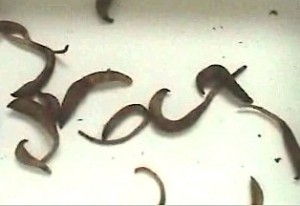This video was made when the diivers collected specimens underwater at Beecher Bay and then when the peanut worms were being used for a lab in the classroom.
Sipunculans, normally called peanut worms are sea animals which live under the rocks and in tight crevices between rocks, especially where is muddy or sand accumulated. They feed on detritus and microscopic organisms. They collect these with the tentacles placed encircling their mouth. They are particularly abundant in Beecher Bay, and also occur in the intertidal, under mussels on the shoreline.Peanut worms are bilaterally symmetrical and unsegmented. The body is divided into two not very distinguished regions. A mobile anterior body section called introvert which can be retracted into the body by a special set of muscles called retractor muscles and a posterior part. At the anterior tip of the body is the mouth surrounded by tentacles. These are usually bushy but sometimes inconspicuous and unbranched. The body cavity, called a coelom, is filled with fluid. Because of this the sipunculans have no respiratory or circulatory system. The coelomic fluid takes care of this functions by transporting both, nutrients and oxygen. In this fluid can also be found free floating cells , hemerytrocytes, and free floating clusters of cells known as ciliary urns. Because the digestive tracts of sipunculans are almost U shaped, the intestine forms a twisted loop, with the anus on the side of the body. Peanut worms are really firm due to to their strong, muscular body wall. Its firmness it’s also increased by the high hydrostatic pressure inside the coelom.
Domain Eukarya
Kingdom Animalia
Phylum Sipuncula
Class Phascolosomatidae
Order Phascolosomatida
Family Phascollosomatidae
Genus Phascolosoma
Species agassizii (Henri Marie Ducrotay de Blainville, 1827)
Common Name:Peanut worm
The length of a large Peanut worm, when stretched out, is about 6 or 7 cm. The posterior part of the body is basically paler or greenish paler while the introvert anterior section is basically paler but with a number of black lines and blotches.
There is some sipuncula fossil evidence proving their existence at least in the Paleozoic. A group of shells called hyoliths were found in rocks through much of the Paleozoic. These hyoliths are conical shells bearing a hinged operculum covering the opening. These shells seem to resemble molluscan shells. However, some trace of intestine has been found in a few hyoliths fossils. This intestine resembles a lot to living sipunculans as it’s looped and coiled. This is more evident as a few living sipunculans secrete calcified cuticular plate, the anal shield. So it is not impossible that past relatives of the sipunculans secreted more extensive shells.
References:
Seashore life of the Puget Sound, the Strait of Georgia, and the Juan Archipelago-Eugene N. Kozloff (1996)
http://www.ldeo.columbia.edu/dees/ees/life/slides/phyla/sipuncula.html
http://www.ucmp.berkeley.edu/sipuncula/sipuncula.html
| Other Members of the Phylum Arthropoda at Race Rocks |
and Image File |
 The Race Rocks taxonomy is a collaborative venture originally started with the Biology and Environmental Systems students of Lester Pearson College UWC. It now also has contributions added by Faculty, Staff, Volunteers and Observers on the remote control webcams. The Race Rocks taxonomy is a collaborative venture originally started with the Biology and Environmental Systems students of Lester Pearson College UWC. It now also has contributions added by Faculty, Staff, Volunteers and Observers on the remote control webcams.
Dec. 2002-Ramiro Nandez (PC yr29) |

